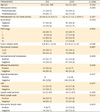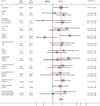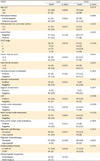1. Callister M, Ramondetta LM, Jhingran A, Burke TW, Eifel PJ. Malignant mixed Müllerian tumors of the uterus: analysis of patterns of failure, prognostic factors, and treatment outcome. Int J Radiat Oncol Biol Phys. 2004; 58:786–796.
2. Vorgias G, Fotiou S. The role of lymphadenectomy in uterine carcinosarcomas (malignant mixed mullerian tumours): a critical literature review. Arch Gynecol Obstet. 2010; 282:659–664.
3. Bansal N, Herzog TJ, Seshan VE, Schiff PB, Burke WM, Cohen CJ, et al. Uterine carcinosarcomas and grade 3 endometrioid cancers: evidence for distinct tumor behavior. Obstet Gynecol. 2008; 112:64–70.
4. Fujii H, Yoshida M, Gong ZX, Matsumoto T, Hamano Y, Fukunaga M, et al. Frequent genetic heterogeneity in the clonal evolution of gynecological carcinosarcoma and its influence on phenotypic diversity. Cancer Res. 2000; 60:114–120.
5. Schipf A, Mayr D, Kirchner T, Diebold J. Molecular genetic aberrations of ovarian and uterine carcinosarcomas: a CGH and FISH study. Virchows Arch. 2008; 452:259–268.
6. Prat J. FIGO staging for uterine sarcomas. Int J Gynaecol Obstet. 2009; 104:177–178.
7. McCluggage WG. Uterine carcinosarcomas (malignant mixed Mullerian tumors) are metaplastic carcinomas. Int J Gynecol Cancer. 2002; 12:687–690.
8. Benito V, Lubrano A, Arencibia O, Andújar M, Alvarez E, Medina N, et al. Clinicopathologic analysis of uterine sarcomas from a single institution in the Canary Islands. Int J Gynaecol Obstet. 2009; 107:44–49.
9. Powell MA, Filiaci VL, Rose PG, Mannel RS, Hanjani P, Degeest K, et al. Phase II evaluation of paclitaxel and carboplatin in the treatment of carcinosarcoma of the uterus: a Gynecologic Oncology Group study. J Clin Oncol. 2010; 28:2727–2731.
10. Abargel A, Avinoach I, Kravtsov V, Boaz M, Glezerman M, Menczer J. Expression of p27 and p53: comparative analysis of uterine carcinosarcoma and endometrial carcinoma. Int J Gynecol Cancer. 2004; 14:354–359.
11. Zelmanowicz A, Hildesheim A, Sherman ME, Sturgeon SR, Kurman RJ, Barrett RJ, et al. Evidence for a common etiology for endometrial carcinomas and malignant mixed mullerian tumors. Gynecol Oncol. 1998; 69:253–257.
12. Bland AE, Stone R, Heuser C, Shu J, Jazaeri A, Shutter J, et al. A clinical and biological comparison between malignant mixed müllerian tumors and grade 3 endometrioid endometrial carcinomas. Int J Gynecol Cancer. 2009; 19:261–265.
13. Zhang C, Hu W, Jia N, Li Q, Hua K, Tao X, et al. Uterine carcinosarcoma and high-risk endometrial carcinomas: a clinicopathological comparison. Int J Gynecol Cancer. 2015; 25:629–636.
14. Felix AS, Stone RA, Bowser R, Chivukula M, Edwards RP, Weissfeld JL, et al. Comparison of survival outcomes between patients with malignant mixed mullerian tumors and high-grade endometrioid, clear cell, and papillary serous endometrial cancers. Int J Gynecol Cancer. 2011; 21:877–884.
15. Galaal K, Kew FM, Tam KF, Lopes A, Meirovitz M, Naik R, et al. Evaluation of prognostic factors and treatment outcomes in uterine carcinosarcoma. Eur J Obstet Gynecol Reprod Biol. 2009; 143:88–92.
16. Vance S, Yechieli R, Cogan C, Hanna R, Munkarah A, Elshaikh MA. The prognostic significance of age in surgically staged patients with type II endometrial carcinoma. Gynecol Oncol. 2012; 126:16–19.
17. Hellström AC, Tegerstedt G, Silfverswärd C, Pettersson F. Malignant mixed müllerian tumors of the ovary: histopathologic and clinical review of 36 cases. Int J Gynecol Cancer. 1999; 9:312–316.
18. Ferguson SE, Tornos C, Hummer A, Barakat RR, Soslow RA. Prognostic features of surgical stage I uterine carcinosarcoma. Am J Surg Pathol. 2007; 31:1653–1661.
19. Nemani D, Mitra N, Guo M, Lin L. Assessing the effects of lymphadenectomy and radiation therapy in patients with uterine carcinosarcoma: a SEER analysis. Gynecol Oncol. 2008; 111:82–88.
20. Otsuki A, Watanabe Y, Nomura H, Futagami M, Yokoyama Y, Shibata K, et al. Paclitaxel and carboplatin in patients with completely or optimally resected carcinosarcoma of the uterus: a phase II trial by the Japanese Uterine Sarcoma Group and the Tohoku Gynecologic Cancer Unit. Int J Gynecol Cancer. 2015; 25:92–97.
21. Takano T, Otsuki T, Tokunaga H, Toyoshima M, Utsunomiya H, Nagase S, et al. Paclitaxel-carboplatin for advanced or recurrent carcinosarcoma of the uterus: the Japan Uterine Sarcoma Group and Tohoku Gynecologic Cancer Unit Study. Int J Clin Oncol. 2014; 19:1052–1058.
22. Reed NS, Mangioni C, Malmström H, Scarfone G, Poveda A, Pecorelli S, et al. Phase III randomised study to evaluate the role of adjuvant pelvic radiotherapy in the treatment of uterine sarcomas stages I and II: an European Organisation for Research and Treatment of Cancer Gynaecological Cancer Group Study (protocol 55874). Eur J Cancer. 2008; 44:808–818.
23. Makker V, Abu-Rustum NR, Alektiar KM, Aghajanian CA, Zhou Q, Iasonos A, et al. A retrospective assessment of outcomes of chemotherapy-based versus radiation-only adjuvant treatment for completely resected stage I-IV uterine carcinosarcoma. Gynecol Oncol. 2008; 111:249–254.
24. Gungorduk K, Ozdemir A, Ertas IE, Gokcu M, Telli E, Oge T, et al. Adjuvant treatment modalities, prognostic predictors and outcomes of uterine carcinosarcomas. Cancer Res Treat. 2015; 47:282–289.











 PDF
PDF Citation
Citation Print
Print



 XML Download
XML Download